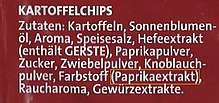Capsorubin
aus Wikipedia, der freien Enzyklopädie
| Strukturformel | |||||||||||||||||||
|---|---|---|---|---|---|---|---|---|---|---|---|---|---|---|---|---|---|---|---|

| |||||||||||||||||||
| Allgemeines | |||||||||||||||||||
| Name | Capsorubin | ||||||||||||||||||
| Andere Namen | |||||||||||||||||||
| Summenformel | C40H56O4 | ||||||||||||||||||
| Kurzbeschreibung |
violettroter Feststoff[2] | ||||||||||||||||||
| Externe Identifikatoren/Datenbanken | |||||||||||||||||||
| |||||||||||||||||||
| Eigenschaften | |||||||||||||||||||
| Molare Masse | 600,87 g·mol−1 | ||||||||||||||||||
| Aggregatzustand |
fest | ||||||||||||||||||
| Dichte | |||||||||||||||||||
| Schmelzpunkt | |||||||||||||||||||
| Löslichkeit | |||||||||||||||||||
| Sicherheitshinweise | |||||||||||||||||||
| |||||||||||||||||||
| Soweit möglich und gebräuchlich, werden SI-Einheiten verwendet. Wenn nicht anders vermerkt, gelten die angegebenen Daten bei Standardbedingungen (0 °C, 1000 hPa). | |||||||||||||||||||
Capsorubin gehört zu den Xanthophyllen (sauerstoffhaltige Carotinoide), es ist ein Naturstoff und zählt zu den Tetraterpenen. Ein System von konjugierten Doppelbindungen absorbiert Licht und verleiht dem Capsorubin eine kräftig rote Farbe. Der Farbstoff wird bei der Herstellung von Lebensmitteln und Kosmetika zum Färben benutzt.
Vorkommen
[Bearbeiten | Quelltext bearbeiten]
Natürliche Quelle für Capsorubin sind Nachtschattengewächse oder Lilien.[2][7][8] Die Menge an Capsorubin im Paprikaextrakt, welches beispielsweise aus Spanischem Pfeffer gewonnen wurde, beträgt 7 % aller Carotinoide. Es ist damit das dritthäufigste Carotinoid, davor kommt Capsanthin mit 37 % und Zeaxanthin mit 8 %.[9]
Biosynthese
[Bearbeiten | Quelltext bearbeiten]Innerhalb der Pflanzengattung der Paprika wird Capsorubin durch enzymatische Pinakol-Umlagerungen synthetisiert. Ausgehend von Violaxanthin, das beim Abbau der Chlorophylle der Pflanze gebildet wird, wird das Intermediat Capsanthin-5,6-epoxid gebildet, das wiederum zu Capsorubin umgewandelt wird.[10]
Verwendung
[Bearbeiten | Quelltext bearbeiten]
Capsorubin ist zusammen mit Capsanthin ein Bestandteil von Paprikaextrakt. Dieser wird unter der Bezeichnung E 160c in der Lebensmittelindustrie geführt. Es dient dazu, Lebensmittel rot einzufärben oder zu aromatisieren. Da es in vielen Anwendungsbereichen keine Mengenbeschränkung gibt, lässt es sich für viele Bereiche einsetzen. Anwendungsbeispiele sind Chips, Getränke, Konfitüre, Käse, Speiseeis oder Suppen.[11][12]
Einzelnachweise
[Bearbeiten | Quelltext bearbeiten]- ↑ Eintrag zu E 160c: Paprika extract, capsanthin, capsorubin in der Europäischen Datenbank für Lebensmittelzusatzstoffe, abgerufen am 16. Juni 2020.
- ↑ a b c d E. Jucker, P. Karrer: Carotinoiden. Springer, Basel 1948, S. 258–259.
- ↑ a b Capsorubin. World of Chemicals, abgerufen am 26. August 2017.
- ↑ Capsorubin. ChemSrc, abgerufen am 26. August 2017.
- ↑ L. Zechmeister: In: Justus Liebigs Annalen der Chemie. 1935, S. 30–45.
- ↑ Dieser Stoff wurde in Bezug auf seine Gefährlichkeit entweder noch nicht eingestuft oder eine verlässliche und zitierfähige Quelle hierzu wurde noch nicht gefunden.
- ↑ Hoffmann La-Rouche, Co.: Carotenoids. Springer. Basel 1971, S. 20.
- ↑ Scientific Opinion on the re-evaluation of paprika extract (E 160c) as a food additive. European Food Safety Authority (EFSA), Parma, Italy 2017, S. 29, doi:10.2903/j.efsa.2015.4320.
- ↑ Scientific Opinion on the re-evaluation of paprika extract (E 160c) as a food additive. European Food Safety Authority (EFSA), Parma, Italy 2017, S. 11–12, doi:10.2903/j.efsa.2015.4320.
- ↑ Klaus Roth: Chemische Leckerbissen, Wiley-VCH, ISBN 3-527-33739-3, S. 140
- ↑ D. Hahne: E-Nummern, Zusatzstoffe: Alle E-Nummern erklärt und bewertet. Stiftung Warentest, 2017, ISBN 978-3-86851-451-3, S. 18–19.
- ↑ G. Lehmann, B. Binkel (Hrsg.): Identifizierung von Farbstoffen in Kosmetika. VCH Verlagsges., Weinheim 1986.
Text is available under the CC BY-SA 4.0 license; additional terms may apply.
Images, videos and audio are available under their respective licenses.
